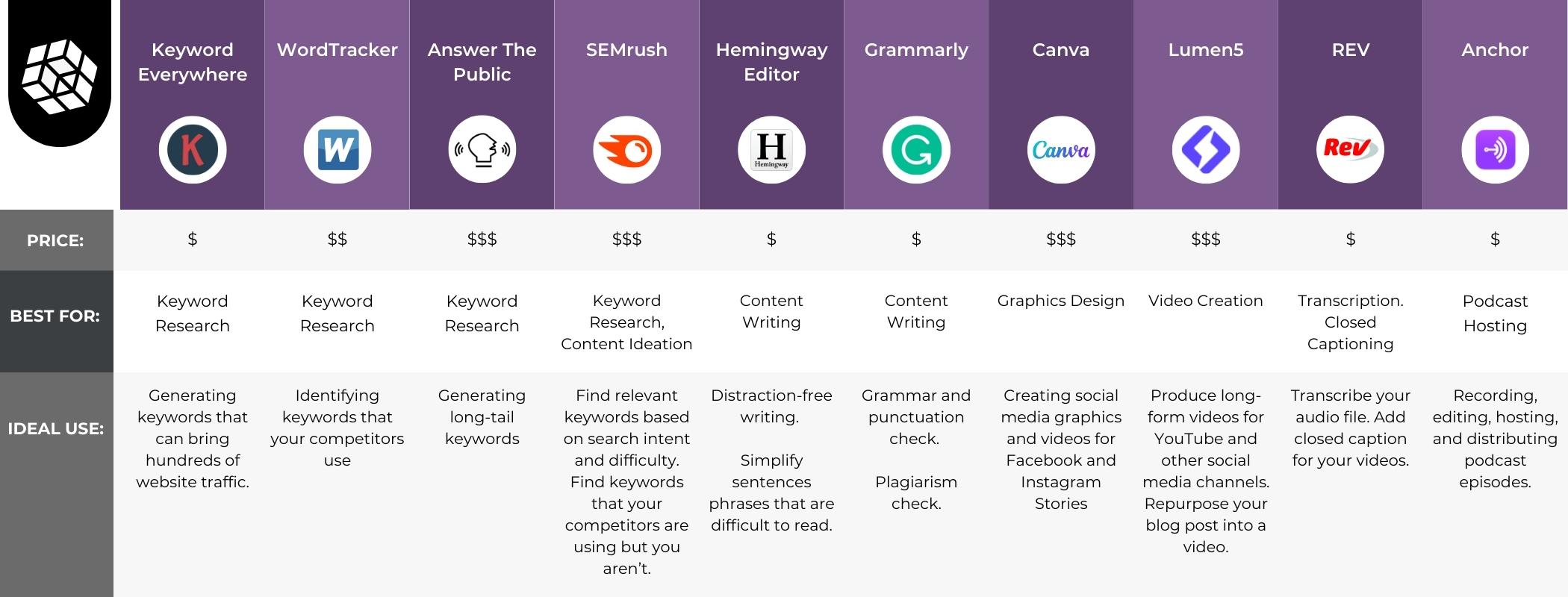Content Marketing Institute defines content marketing as “a strategic marketing approach focused on creating and distributing valuable, relevant, and consistent content.”
The role of content in marketing is to attract, nurture, and convert your target audience. These are people interested in what your brand can offer. As such, your business must have a solid content marketing strategy.
Mind you, big and small companies use content marketing, especially when the COVID-19 pandemic hit. Because people were required to stay home, many started spending most of their time online. As such, many brands saw the situation as a prime opportunity to leverage content marketing and be at the forefront of their target audience.
The CMI’s research revealed that 72% of B2C companies intend to increase their investment to produce more video content. The same goes for 69% of B2B companies, who consider increasing their budget for hybrid events (39%) and retaining their funding for digital events (41%).
9 Types of Content That Businesses Can Use
Here’s the thing: Content marketing is more than just ensuring you publish a blog post regularly. As previously mentioned, companies intend to increase their budget for video production. Some businesses will increase or retain their funding for digital events, meaning they will keep producing webinars.
Here’s the thing: Content marketing is all about storytelling. However, you might wonder what’s the best way to tell your story.
That said, listed are nine types of content that you can use for your business:
Blog Posts
Blog posts are perhaps the most popular type of content that you could think of. That’s because detailed and long-form content allows you to incorporate your target keywords. It also lets you expand your marketing message, enabling your business to drive profitable customer action.
White Papers, eBooks, and Reports
Another type of long-form content, white papers, eBooks, and reports, allows you to provide industry insight and more details to your audience. No wonder they tend to have a higher word count than a blog post.
Aside from showcasing an in-depth level of expertise and driving organic traffic, this content is helpful for collecting lead information.
Case Studies
If you own a B2B company, it is vital that you have case studies. That’s because 7 out of 10 potential clients are influenced by case studies when making a purchasing decision. Sure, they are time-consuming and require many resources to produce, but keep in mind that they bear substantial weight. That’s because case studies showcase how your services can help other businesses.
Newsletters and Nurturing Content
Whether you are a B2C or B2B company, email marketing can help you bring desirable results. It can be website traffic, conversion, or sales. What’s great about email newsletters and nurturing content is that they are simple and concise. Hence, you only need to be creative and mindful of your subject lines and ensure consistency in your content production.
Social Media Posts
While not every business has a budget to start a website, brands need to have a social media presence. However, using a social network for content is not enough. You should leverage this channel to interact with your customers, provide informational content, and promote products.
Infographics
Not everyone prefers to consume text. Some of your target audiences are thirty times more likely to consume information presented in eye-catching graphics. This is where infographics can come in handy.
Podcast
Podcasts were not a big deal more than ten years ago. Nowadays, more than half of the American population has listened to at least one podcast episode. This is ideal if you prefer to share your knowledge verbally than written but are too shy for the camera.
Videos
In case you do not know, 75 million people in the United States watch videos online every day. That’s because the past year has made it easy for people to consume video content. This also explains that you should consider producing videos for your business.
Webinars
According to a ClickMeeting research, 76% of B2B clients made a purchase after watching a webinar. That said, you might consider regularly producing a relevant, informative, and engaging webinar to educate clients, drive leads, and close deals.
6 Steps to Build an Effective Content Marketing Strategy for Your Business

Go back to CMI’s definition of content marketing again. Remember that this marketing approach is more than just producing and distributing content. You also must ensure they are valuable and relevant to your target audience – your potential and existing customers.
That said, here are six steps on how you can build an effective content marketing strategy for your business:
STEP 1: Identify Your Content Marketing Goal
In every campaign that you do for your business, it is essential that you have a goal. Content marketing is not an exemption.
That said, you should ask yourself what you want to achieve through your content. Doing so can help you identify what distribution channels you will use and the type of content that you will have to produce.
At ArisAlex, our content marketing goals include the following:
- Drive quality traffic to our website
- Build brand awareness
- Generate high-quality leads
- Nurture and convert leads to paying clients
Depending on your business’s nature, your content marketing goal can also include generating sales or driving engagement.
STEP 2: Know Your Audience Persona
Aside from determining your goals, it is also imperative to know your target audience. Doing so can help you produce content that resonates with them.
You can determine your audience persona based on market research and actual data from your existing customers. Nonetheless, you do not have to make a single persona. You can create multiple audience personas if your business caters to different types of customers.
Another thing you should consider is how they will interact with your business when they are at different stages of the marketing funnel. That’s because your customers are likely to consume different kinds of content depending on where they are in their buyer’s journey.
STEP 3: Do a Content Audit
As mentioned earlier, content is more than just your blog post. That said, it is vital to determine your owned, earned, and paid content.
- Owned content is any content that you own and control. This can be your blog posts, eBooks, podcasts, and YouTube videos.
- Earned content is any content about you created by other parties. This can be product reviews, social media mentions, and press releases.
- Paid content is any content that you paid for. An excellent example of this would be your search ads, banner ads, and social media ads.
You can use various web analytics tools such as Google Analytics to compile a list of your existing content. Once you compile a list of content you own, earn, and pay for, the next step is determining which of them are bringing you ROI.
Perhaps your blog generates thousands of organic website traffic, while your search ads are the primary sales driver. Should you ditch one of them? Not necessarily. Nonetheless, this should give you an insight into which channels help you bring in quick wins and foster brand awareness and loyalty.
You might ask: What if I’m starting my company website from scratch?
It would help to determine whether you produced and published content elsewhere, such as LinkedIn articles. These are still owned content. If an influencer or customer mentions you or your product, it is still earned content. Hence, you need to collect those and measure their performance.
Otherwise, you can proceed with the next step.
STEP 4: Pick Your Distribution Channels
A distribution channel is any platform where you publish your content, including your blog, email newsletter, and social media pages. Whichever distribution channel you choose will depend on two things:
- Your content marketing goal
- Your target audience
If your goal is to drive high-quality traffic to your website, it will only make sense if you produce informative and relevant blog posts.
When it comes to social media, though, you might want to be selective about it. For instance, a B2B company can use TikTok and Instagram to showcase company culture, which could come in handy for recruitment. Meanwhile, they can increase their chances of generating leads through LinkedIn.
STEP 5: Determine What Content to Produce
Now that you know what distribution channels you will use, the next step is determining what content to produce.
Knowing the types of content can be easy at this point. However, knowing what topics to cover can cause analysis paralysis. Luckily, some tools can help you generate content ideas. You can also check out what your competitors are doing and fill in the gap.
What’s important is that you produce content that resonates with your target audience.
STEP 6: Produce and Manage Your Content
Content marketing does not end with clicking the “publish” button. It is also vital that you have an editorial process. This includes an editorial calendar where you organize and manage your content. Another thing you should have is a report that helps you measure how your content is performing.
10 Beginner-Friendly Content Marketing Tools
Now that you know the steps to build an effective content marketing strategy, you might be thinking about how you can execute it smartly. That said, we have listed ten beginner-friendly content marketing tools that you can use.

Keywords Everywhere
Keywords Everywhere is a freemium browser extension that aids your keyword research. With the free version, you can find keywords related to your search query. The best part is that it will seamlessly show you a handful of valuable information and metrics while going through a Google or YouTube search.
When to use Keywords Everywhere? This is ideal if you want to know whether a target keyword can bring in hundreds of website traffic.
WordTracker
WordTracker is another handy keyword research tool. What differentiates it from Keywords Everywhere is that it gives you insight into your competitors’ keywords. Thus, you can use this tool to know what keywords businesses like yours use. Doing so helps you develop potential content topics when starting your content marketing strategy from scratch.
Answer the Public
Answer The Public visualizes search queries and suggests autocomplete searches.
You must type in your target keyword, pick a country (preferably where most of your target audience lives), and a language. You can see a map visualization of relevant keywords grouped into specific categories like the 5 Ws, comparisons, and prepositions.
Using Answer The Public can help with keyword mapping, wherein you determine which keywords should be grouped.
SEMrush
Perhaps the most advanced tool in this list, SEMrush is your all-in-one tool for keyword research and content idea research. However, this tool is best used for content gap analysis.
SEMrush has a “Keyword Gap” feature wherein you can list your website and that of your competitors. From there, the tool will list down the keywords that your competitors are targeting, but you are not. This can give you an insight into content opportunities you can take advantage of.
Hemingway Editor
Hemingway Editor is a self-editing tool that helps you write clearn and concise content. It highlights sentences that are difficult to read, statements in passive voice, phrases with simpler alternatives, and more.
What’s great about this content marketing tool is that you can toggle between “Edit” and “Write.” The latter allows you to have a distraction-free text editor.
Grammarly
Grammarly dubs itself as an online writing assistant. That’s because the free version helps improve your content according to your set parameters, like target audience, language preference, and writing style. Meanwhile, the paid version allows you to run a plagiarism check on your content to ensure that it is original.
Canva
One of our favorite content marketing tools, Canva is an online graphic design tool. It lets you create multimedia content for various social media channels, presentation decks, and marketing collaterals. You can quickly start with a template or from scratch, as this tool does not require extensive photo editing knowledge.
Lumen5
Lumen5 is a video-creating tool that lets you produce engaging videos for different social media channels like YouTube, social media stories, and more in minutes. What’s cool about this tool is that you can turn your blog post – or any written long-form content – into a video!
REV
REV is an online speech-to-text platform that provides transcription and closed captioning services.
Why would you need a transcription tool? That’s because 8 out of 10 people watch videos without sound, and a closed caption can help them consume content without audio. It also improves your Search Engine Optimization efforts as it can help your content rank better for your target keywords.
Anchor
Anchor is your one-stop shop for podcast production. The platform allows you to record, edit, host, and distribute your podcast on major channels like Spotify, Google, and iTunes. It also has a mobile app, allowing you to produce online content while on the go.
What keeps your content from being an informational garbage people is its value and relevance. Your target audience is likely receiving and filtering through tons of information they see online.
How can you stand out above the noise? The answer is in how robust your content marketing strategy is.





